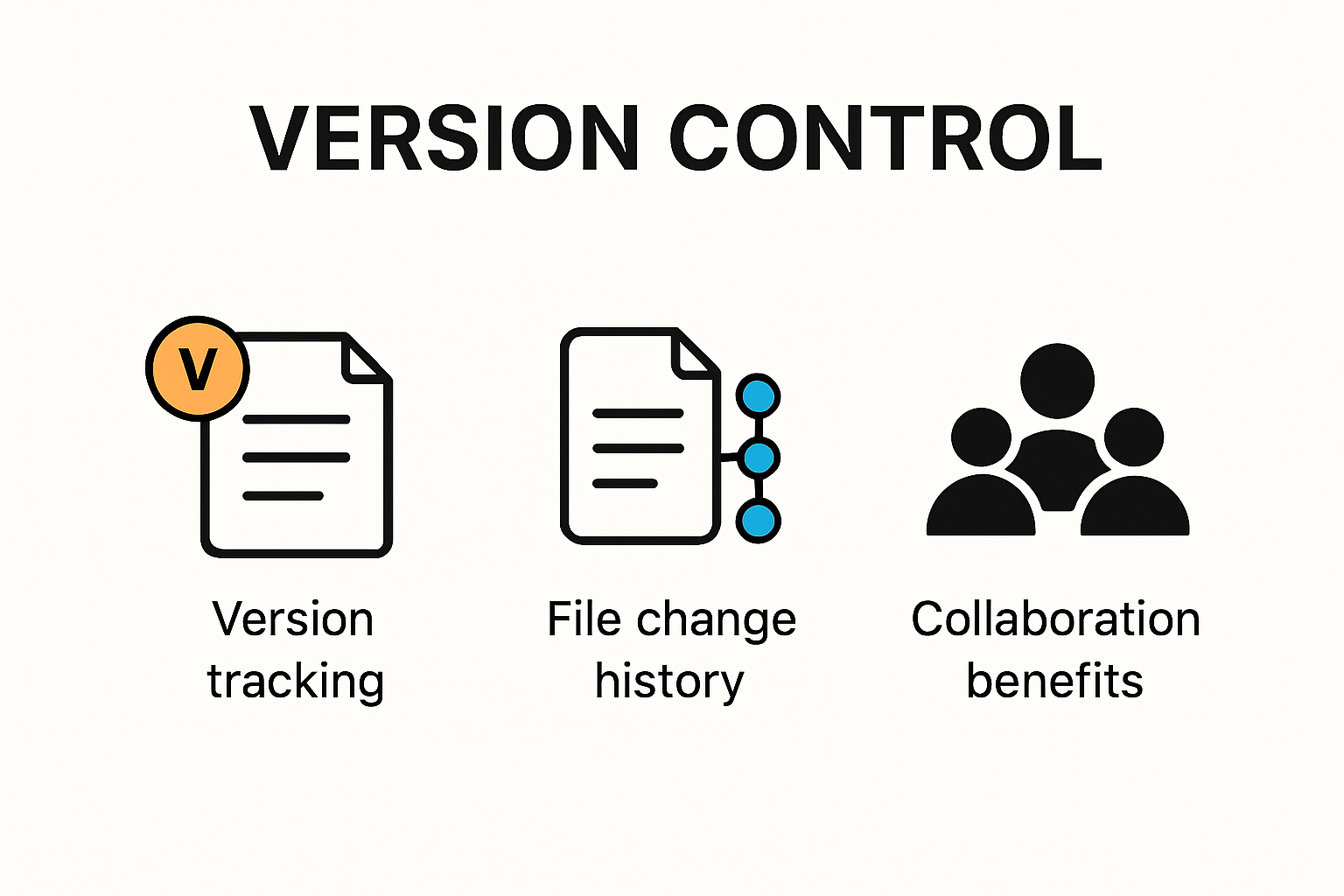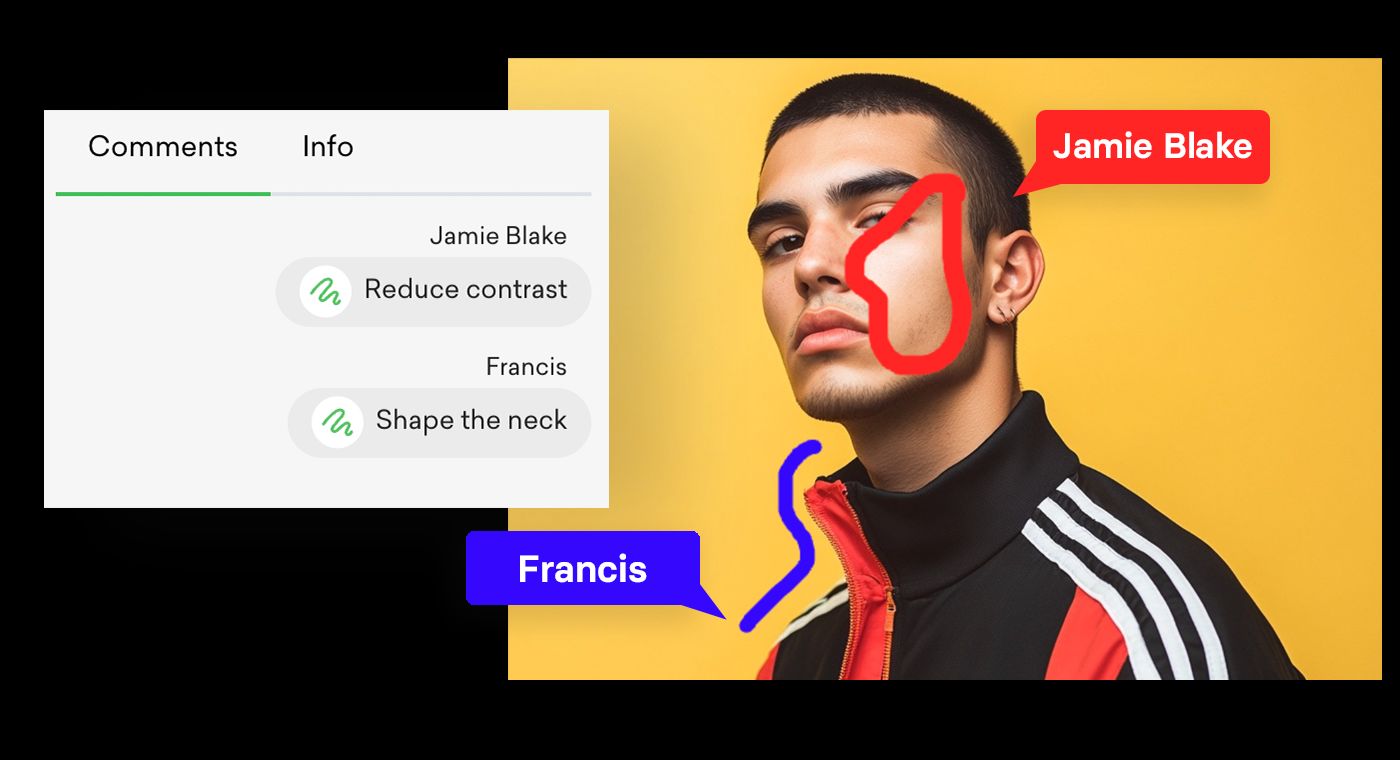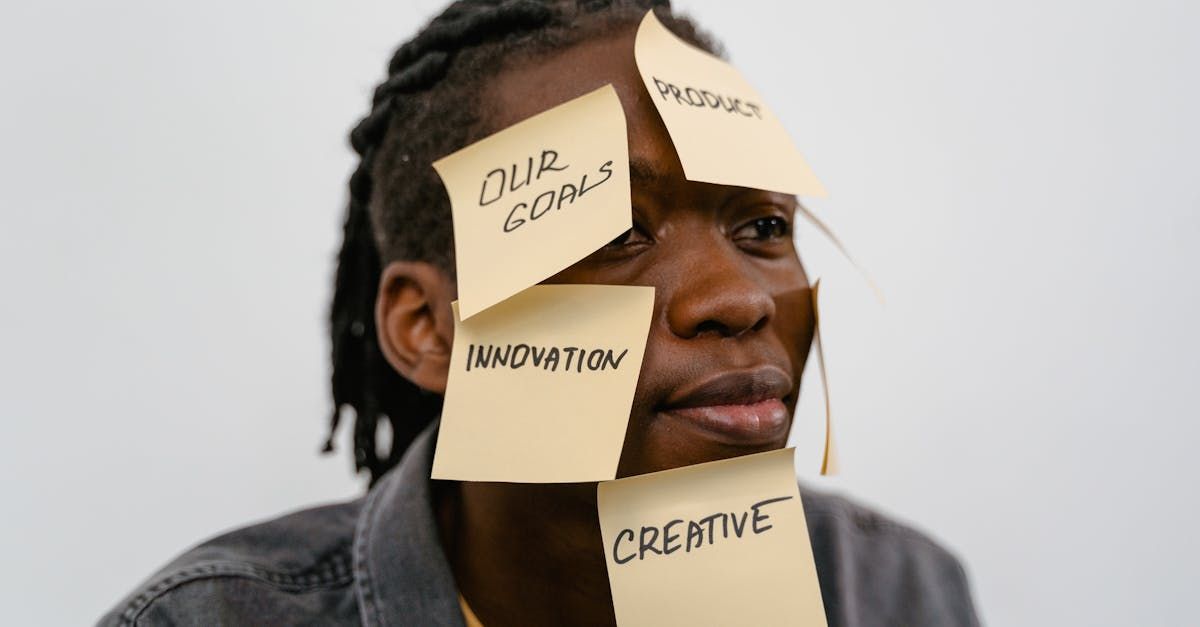Every creative team has wrestled with the chaos of keeping track of design drafts and endless file versions. Think about this: some studios accidentally lose up to 30 percent of their digital assets each year, just from messy file management. Most people assume this is just the cost of doing creative work, like a headache you have to live with. The truth is version control systems can flip that chaos on its head and make sure not a single piece of your creative work ever goes missing again.
Table of Contents
Quick Summary
| Takeaway | Explanation |
| Version control preserves creative work | It tracks every modification, ensuring no important changes are lost. |
| Facilitates seamless collaboration | Team members can edit files simultaneously without overwriting each other’s work. |
| Enables project recovery | Reverting to previous versions becomes easy if a recent change doesn’t meet expectations. |
| Establish clear guidelines for teams | Standardizing naming conventions and permissions streamlines workflows and reduces confusion. |
| Regular audits maintain project quality | Conduct systematic reviews and document significant changes to ensure the integrity of creative work. |
Explaining Version Control for Creatives
Creative professionals often wrestle with complex file management challenges that can derail project workflows and collaboration. Version control emerges as a critical solution for photographers, designers, and content creators seeking systematic approaches to tracking file changes and maintaining project integrity.
What Exactly Is Version Control?
Version control represents a sophisticated tracking system that records modifications to files over time. Unlike basic file naming methods like “design_final_v1” or “photo_edit_final_final”, version control provides a robust framework for documenting every single change in a project. Mozilla’s Developer Network explains that version control systems allow professionals to review previous file states, understand who made specific changes, and restore earlier versions if needed.
For creative professionals, this means maintaining a comprehensive history of your work. Imagine a scenario where a photographer accidentally overwrites a critical RAW file or a graphic designer loses an important design iteration. Version control acts as a safety net, preserving each meaningful modification and providing a clear historical trail of project development.

How Version Control Benefits Creative Workflows
Version control transcends simple file backup. The University of Alabama’s Web Hub highlights that effective version control enables multiple team members to collaborate seamlessly without risking data loss or conflicting edits. Creative teams can work simultaneously on projects, tracking individual contributions and maintaining a clear, organized workflow.
Key advantages for creative professionals include:
-
Comprehensive Tracking: Every file modification gets documented with precise details about when and who made changes.
-
Collaborative Protection: Multiple team members can work on the same project without risking accidental data overwrite.
-
Project Recovery: Ability to revert to previous file versions if an edit doesn’t meet project requirements.
Creative workflows often involve intricate design processes, complex photo editing, and collaborative content creation. Version control provides a structured approach to managing these multifaceted projects, ensuring that no creative insight gets lost in the process.
While traditional file management methods rely on manual tracking and potentially confusing naming conventions, version control systems offer a professional, systematic approach to preserving creative work. By implementing robust version control strategies, photographers, designers, and content creators can focus more on their artistic vision and less on file management complexities.
Why Version Control Matters in Creative Work
Creative professionals operate in dynamic environments where precision, collaboration, and adaptability are paramount. Version control emerges as a critical tool that transforms how photographers, designers, and content creators manage their complex workflows and protect their intellectual property.
Protecting Creative Investments
Coursera’s Technology Guide highlights that version control is not just a technical mechanism but a strategic approach to preserving creative work. In industries where every design iteration, photoshoot variant, or content revision represents significant time and resource investment, having a systematic method to track changes becomes essential.
Imagine a graphic designer working on a brand identity project. Without version control, a single mistaken edit could erase hours of careful design work. Version control provides a safety net, allowing professionals to experiment boldly while maintaining the ability to revert to previous states if an experiment doesn’t yield the desired result.
Collaborative Workflow Optimization
New York University’s Data Management Guide emphasizes that version control transforms collaborative processes. In creative teams where multiple professionals might work simultaneously on different aspects of a project, version control ensures that contributions are tracked, integrated, and protected.
Key collaborative advantages include:
-
Simultaneous Editing: Team members can work on the same project without fear of overwriting each other’s work.
-
Clear Contribution Tracking: Every change is documented with precise attribution.
-
Conflict Resolution: Built in mechanisms help manage and merge different team members’ contributions.
Maintaining Project Integrity and Accountability
UK Government’s Technology Manual points out that version control creates an unambiguous record of project evolution. For creative professionals, this means creating a transparent history of how a project developed from initial concept to final delivery.
This accountability becomes crucial in client-facing industries. Photographers can demonstrate the progression of an image edit, designers can show the strategic decisions behind a brand design, and content creators can illustrate the refinement process of their work.
Version control transcends simple file management. It represents a professional approach to creativity that values precision, collaboration, and continuous improvement. By implementing robust version control strategies, creative professionals transform potential chaos into structured, manageable workflows that protect their most valuable asset: their creative vision.
Top Tools for Managing Creative Versions

Creative professionals require sophisticated version control solutions that understand the nuanced needs of visual content management. Unlike traditional software development tools, creative version control demands platforms that can handle large files, complex visual assets, and seamless collaborative workflows.
Cloud Based Version Control Solutions
Modern creative teams need robust platforms that go beyond simple file storage. Adobe Creative Cloud offers integrated version tracking for creative files, allowing designers and photographers to maintain comprehensive project histories. These cloud solutions provide automatic versioning, enabling professionals to track changes across design iterations without manually managing multiple file versions.
Key features of cloud based version control include:
-
Automatic File Versioning: Tracks changes without manual intervention
-
Collaborative Sharing: Enables team members to access and review project history
-
Seamless Integration: Works directly within creative software environments
Specialized Creative Version Management Platforms
Pixelixe Design Platform highlights that specialized version control tools for creatives offer more than standard file tracking. These platforms understand the complexity of visual content, providing context aware versioning that captures not just file changes but design evolution.
Professional creative version control platforms typically offer:
-
Visual Change Tracking: Shows precise visual differences between file versions
-
Metadata Preservation: Maintains important file information across iterations
-
Permission Based Access: Controls who can view or modify project versions
Open Source and Professional Version Control Systems
While many creative professionals use proprietary platforms, open source solutions like Git provide powerful version control capabilities. These systems offer flexibility for teams willing to implement more technical version tracking approaches.
Open source version control provides advantages such as:
-
Complete Version History: Detailed tracking of every project modification
-
Branching Capabilities: Allows simultaneous experimental work streams
-
Cross Platform Compatibility: Works across different operating systems and creative tools
Choosing the right version control tool depends on specific workflow requirements. Creative professionals must evaluate factors like team size, project complexity, file types, and integration capabilities when selecting a version management solution.
The ideal version control system transforms file management from a technical challenge into a strategic workflow enhancement. By implementing the right tools, creative teams can focus more on innovation and less on administrative file tracking, ultimately improving productivity and creative output.
Here’s a comparison table summarizing the three main types of version control solutions for creatives, highlighting their features and strengths:
| Solution Type | Key Features | Strengths |
| Cloud Based Version Control | Automatic file versioning, collaborative sharing, seamless integration | User-friendly, integrates with creative software, easy access |
| Specialized Creative Version Platforms | Visual change tracking, metadata preservation, permission-based access | Tailored for visual content, context-aware, detailed previews |
| Open Source/Professional Version Control | Complete version history, branching, cross-platform compatibility | Highly flexible, technical control, supports complex workflows |
Best Practices for Creative Teams and Agencies
Creative teams and agencies operate in complex environments where collaboration, precision, and efficiency are paramount. Implementing robust version control practices becomes crucial for maintaining project quality, protecting creative work, and ensuring smooth team interactions.
Establishing Clear Version Control Guidelines
Perforce Software emphasizes the importance of creating comprehensive version control guidelines that provide a structured approach to file management. These guidelines serve as a roadmap for team members, ensuring consistency and reducing potential confusion during collaborative projects.
Key elements of effective version control guidelines include:
-
Standardized Naming Conventions: Create clear rules for file and version naming
-
Commit Message Protocols: Develop a systematic approach to documenting changes
-
Access and Permission Frameworks: Define who can make and approve modifications
By establishing these guidelines, creative teams create a shared language that streamlines workflow and reduces miscommunication. This approach transforms version control from a technical requirement into a strategic team management tool.
Below is a summary table of best practice areas for creative version control and their purpose:
| Practice Area | Purpose | Example Element |
| Naming Conventions | Ensures consistency and clarity | “projectname_version_date.psd” |
| Commit Message Protocols | Documents and explains file changes | “Updated color palette” |
| Permission Frameworks | Controls file modification and approvals | Read/Write roles assigned |
| Regular Backups | Safeguards against data loss | Daily automated backups |
| Project Audits | Reviews version histories for accuracy | Monthly version review meeting |
Implementing Collaborative Workflow Strategies
ArtworkflowHQ highlights the critical importance of creating a collaborative environment that supports creative innovation while maintaining project integrity. This involves developing strategies that allow team members to work simultaneously without risking data loss or conflicting edits.
Effective collaborative strategies include:
-
Dedicated Experimentation Branches: Create safe spaces for creative exploration
-
Centralized Feedback Mechanisms: Implement structured review processes
-
Regular Team Training: Ensure all members understand version control protocols
Maintaining Project Integrity and Quality
ProofHub recommends a proactive approach to maintaining project quality through rigorous version control practices. This goes beyond simple file tracking, focusing on creating a comprehensive system that protects creative work and facilitates team collaboration.
Quality maintenance strategies involve:
-
Regular Backup Protocols: Implement multiple backup systems
-
Comprehensive Change Tracking: Document every significant project modification
-
Periodic Project Audits: Conduct systematic reviews of project version histories
Successful version control in creative environments requires more than technical implementation. It demands a cultural shift that values systematic documentation, collaborative transparency, and continuous improvement. Creative teams that embrace these practices transform version control from a mundane administrative task into a powerful tool for creative excellence.
By investing time in developing robust version control strategies, agencies and creative teams can protect their intellectual property, streamline collaboration, and create an environment that nurtures innovation while maintaining the highest standards of professional practice.
Frequently Asked Questions
What is version control in creative work?
Version control is a system that tracks and records changes to files over time, allowing creative professionals to document modifications, collaborate effectively, and restore previous versions if needed.
Why is version control important for creative teams?
Version control is crucial for creative teams as it helps protect their investments by preserving every design iteration, enables seamless collaboration without data loss, and maintains project integrity through clear documentation of changes.
What are some popular version control tools for creatives?
Popular version control tools for creatives include Adobe Creative Cloud for cloud-based file management, specialized platforms like Pixelixe for visual content, and open-source systems like Git that provide flexible version control capabilities.
How can creative teams implement effective version control practices?
Creative teams can implement effective version control practices by establishing clear guidelines, using standardized naming conventions, conducting regular audits, and fostering a collaborative workflow that supports simultaneous editing.
Transform Creative Chaos Into Clarity With Pikd
If you’re tired of lost files, confusing version names, or messy project folders, you are not alone. The article shows that creative professionals struggle with disorganized assets, accidental overwrites, and endless searching for the right file version. These moments can lead to stress, missed deadlines, or even lost income. Real version control—one that is made for photographers and visual creators—should not feel out of reach.

Pikd gives you all the control you crave, designed with your workflow in mind. Track every change. Collect client feedback instantly. Collaborate with your team on high-res images or videos without sacrificing quality or clarity. No apps. No clunky file transfers. Just smooth, visual-first galleries and real-time comments that protect your work at every step. Ready to move from disorganized chaos to streamlined creativity right now? Discover how Pikd can safeguard your creative process today and see why visual professionals are switching to a better system for sharing and review. Take the next step and experience stress-free creative collaboration—explore Pikd now.

































